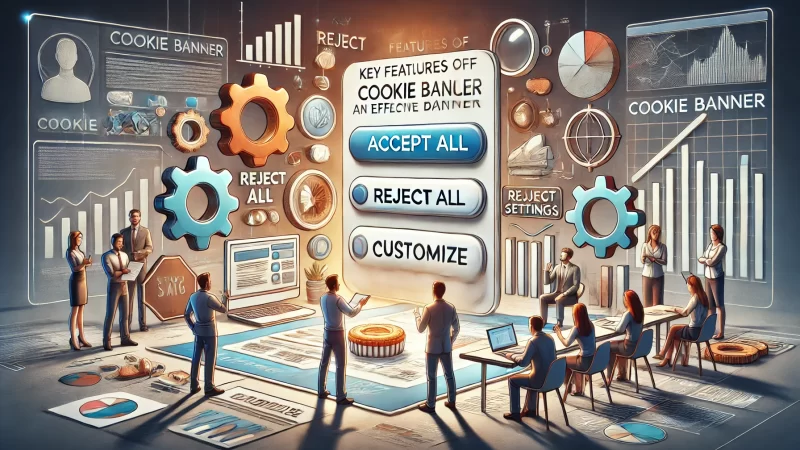Does your website have a cookie banner that’s compliant with privacy laws like GDPR and CCPA? Are you confident it meets legal standards while providing a smooth user experience? A cookie banner isn’t just a legal formality—it’s a powerful tool to build trust, enhance credibility, and protect your business from hefty penalties.
In this article, we’ll explore everything you need to know about creating an effective, compliance-friendly cookie banner. From understanding its benefits to avoiding common mistakes and staying updated with privacy law trends, you’ll find actionable insights to ensure your website remains legally secure and user-friendly. Let’s dive in!
Understanding Cookie Banners
A cookie banner is a fundamental feature on modern websites, enabling compliance with privacy laws while fostering transparency with users. By educating yourself about cookie banners, you can better understand their purpose and ensure your website uses them effectively.
What Is a Cookie Banner?
A cookie banner is a notification displayed on websites to inform users about data collection practices. It typically requests users’ consent to store cookies on their devices, ensuring they are aware of how their data will be used.
For example, when you visit a website for the first time, you might see a pop-up asking if you accept or reject cookies. This banner is more than a formality; it acts as a digital handshake, prioritizing transparency and building trust with users. By clearly stating what data is being collected, businesses empower visitors to make informed decisions.
An effective cookie banner should be simple and user-friendly. Avoid overwhelming text and technical jargon—use clear language that anyone can understand. Adding options like “Accept All,” “Reject All,” or “Customize Preferences” improves usability and ensures compliance.
Moreover, cookie banners are part of broader efforts to align with privacy laws, such as GDPR in Europe or CCPA in California. They ensure websites respect users’ rights while maintaining functionality and personalization.
How Cookie Banners Work on Websites
Cookie banners function as intermediaries between a website’s backend and its users, allowing consent management in real time. When a visitor lands on your site, the banner detects the need for consent based on their location or applicable laws.
The moment users interact with the banner—whether by accepting, rejecting, or customizing their preferences—the website stores this choice. This interaction is often saved using a cookie itself, so users aren’t repeatedly prompted when they revisit the site.
Modern cookie banners often integrate with consent management platforms (CMPs). These tools streamline compliance by ensuring cookies are only activated once the user provides explicit consent. For example, a CMP might disable tracking or advertising cookies until users opt in, safeguarding their privacy.
It’s essential to test the banner’s functionality to prevent unintended cookie activation. A misconfigured banner could lead to non-compliance or user frustration. By regularly reviewing and refining your cookie banner’s performance, you can enhance its effectiveness and maintain trust.
Types of Cookie Banners and Their Purposes
Cookie banners come in various forms, each designed to suit specific needs and regulatory requirements. Understanding these types can help you select the best option for your website.
- Implied Consent Banners: These banners inform users about cookies but assume their consent if they continue using the site. While they are less intrusive, they may not meet stricter legal standards, such as GDPR.
- Explicit Consent Banners: These require users to actively accept or reject cookies before they are activated. They align with most privacy laws and demonstrate a higher commitment to user privacy.
- Customizable Consent Banners: These offer users the ability to manage preferences, choosing which categories of cookies (e.g., functional, analytical, marketing) they wish to accept. This approach empowers users and ensures compliance with comprehensive laws.
- Full-Screen Consent Pages: These banners take over the screen until the user interacts with them, ensuring maximum visibility. While effective, they can be intrusive if not designed thoughtfully.
Each type serves a unique purpose, so consider your audience, legal obligations, and website functionality when implementing a cookie banner. For instance, an e-commerce site might prioritize customizable banners to align with data-driven marketing strategies, while a news site may opt for explicit consent to foster user trust.
Importance of Cookie Compliance

Cookie compliance isn’t optional—it’s a legal and ethical obligation for businesses operating in the digital age. Adhering to cookie laws safeguards user rights while protecting your business from regulatory risks.
Legal Requirements for Cookie Consent
Global privacy laws like GDPR, CCPA, and ePrivacy Directive require websites to obtain user consent before activating non-essential cookies. This ensures transparency and accountability in how personal data is collected and used.
For example, GDPR mandates that users must actively opt in to cookies, with a clear explanation of their purpose. Consent must be specific, informed, and freely given—pre-ticked boxes or vague disclaimers no longer suffice. In California, the CCPA focuses on providing users with the ability to opt out of data sales, making clear cookie disclosures equally critical.
To comply, your cookie banner should explicitly outline cookie categories and their uses. Include links to detailed policies or preference management pages. This transparency reduces the risk of legal penalties and reinforces your commitment to privacy.
Consequences of Non-Compliance with Cookie Laws
Failing to comply with cookie regulations can have severe consequences for your business, both financially and reputationally. Regulatory authorities impose hefty fines on companies that breach these laws, and non-compliance may erode trust among your audience.
For instance, under GDPR, fines can reach up to €20 million or 4% of global annual turnover, whichever is higher. Companies like Google and Amazon have faced millions in penalties for cookie violations, highlighting the importance of adherence.
Beyond financial risks, users are more privacy-conscious than ever. A poorly implemented or misleading cookie banner can drive visitors away, reducing engagement and conversions. By prioritizing compliance, you demonstrate respect for your audience and foster loyalty.
How a Cookie Banner Ensures Legal Adherence
Cookie banners act as the first line of defense for legal compliance, aligning your website with privacy laws worldwide. By securing consent, they ensure that data collection practices are both lawful and ethical.
For example, a well-designed cookie banner prevents cookies from activating until the user explicitly agrees. This protects your business from accusations of unauthorized data collection. It also provides users with control over their preferences, fulfilling requirements like GDPR’s “right to be informed.”
Investing in a robust consent management platform can simplify the process. These tools automate compliance checks, update your banner to reflect evolving laws, and provide audit trails to demonstrate your efforts. By using a cookie banner as a proactive measure, you protect both your users’ privacy and your business interests.
Benefits of a Compliance-Friendly Cookie Banner
A compliance-friendly cookie banner does more than meet legal requirements—it builds trust, enhances your brand’s credibility, and shields your business from potential legal troubles. Embracing this tool can transform user experiences and safeguard your operations.
Enhancing User Trust Through Transparency
Transparency is a cornerstone of building trust, and a compliance-friendly cookie banner delivers just that. When users see clear explanations about how their data is collected and used, they feel more in control.
For example, a cookie banner that categorizes cookies (e.g., functional, analytics, marketing) and explains their purpose reassures users that your site respects their privacy. This transparency encourages users to engage with your website confidently, knowing their data isn’t being misused.
A survey revealed that 86% of users feel more inclined to trust websites with transparent cookie policies. Trust leads to increased user retention, as visitors are more likely to return when they feel their data is handled responsibly.
Adding options like “Customize Preferences” further boosts trust by giving users control over their consent. A compliance-friendly cookie banner isn’t just a requirement—it’s an opportunity to establish a lasting relationship with your audience.
Boosting Your Website’s Credibility
A professional and compliance-friendly cookie banner sends a clear message: your website values integrity. In today’s privacy-conscious world, this credibility can set your site apart.
When users encounter an informative cookie banner, it shows you’re aligned with global standards like GDPR or CCPA. This alignment doesn’t just build trust; it positions your brand as one that prioritizes legal and ethical practices.
Credibility can directly influence conversions. For instance, e-commerce websites with clear cookie policies often experience higher sales, as users feel safer completing purchases. On the other hand, neglecting cookie compliance can tarnish your reputation and lead to negative reviews.
Showcasing compliance badges or certifications alongside your cookie banner reinforces your commitment to privacy. A compliance-friendly cookie banner is more than a legal safeguard—it’s a credibility booster.
Avoiding Hefty Fines and Penalties
Ignoring cookie compliance can lead to severe financial repercussions. A compliance-friendly cookie banner helps you avoid fines while demonstrating your commitment to lawful practices.
Take GDPR as an example. Fines for non-compliance can reach up to €20 million or 4% of annual turnover. In 2021, Amazon faced a €746 million penalty for cookie-related violations. A simple, well-implemented cookie banner could have prevented this.
Beyond fines, there are reputational risks. Negative publicity from privacy violations can damage your brand’s image, driving users away and hurting revenue. By prioritizing cookie compliance, you shield your business from unnecessary risks and maintain user trust.
Adopting a compliance-friendly cookie banner ensures you’re not caught off guard by evolving regulations. Regularly reviewing and updating your banner keeps your business protected and legally compliant.
Key Features of an Effective Cookie Banner

An effective cookie banner isn’t just compliant—it’s user-friendly, adaptable, and designed to meet the diverse needs of your audience. Incorporating the right features ensures a seamless experience for users and compliance with global standards.
Customization Options for Different User Needs
No two websites are the same, and an effective cookie banner reflects this diversity. Customization options let you tailor the banner to suit your site’s unique needs and your audience’s preferences.
For instance, an e-commerce website might prioritize banners that allow users to select cookie categories (e.g., marketing, analytics), while a blog could focus on a simple opt-in or opt-out approach. Customizable banners make users feel in control without overwhelming them.
You can also match your banner’s design to your site’s branding. Consistent fonts, colors, and layout ensure the banner feels like a cohesive part of your website rather than an intrusive pop-up.
Interactive features, like collapsible details or tooltips, further enhance usability. These features provide additional information without cluttering the screen, ensuring users have a smooth experience.
Multilingual Support for Global Compliance
A multilingual cookie banner ensures accessibility and compliance across different regions. When users can interact with the banner in their native language, they’re more likely to engage and provide informed consent.
For example, if your website serves audiences in Europe, Asia, and South America, your cookie banner should support languages like French, German, Spanish, and Mandarin. A monolingual banner might alienate non-English speakers, reducing trust and potentially leading to non-compliance.
Integrating a language detection feature ensures users see the banner in their preferred language automatically. This feature demonstrates cultural sensitivity while simplifying the consent process.
Remember, multilingual support isn’t just about translation. It’s also about ensuring compliance with regional privacy laws, which often require consent wording to be legally precise in the local language.
Easy Integration with Existing Websites
An effective cookie banner should integrate seamlessly with your existing website infrastructure. A clunky, poorly integrated banner can disrupt user experiences and damage your site’s functionality.
Most modern cookie banners come with plug-and-play solutions that work with popular CMS platforms like WordPress, Shopify, or Wix. These tools simplify installation and configuration, reducing the need for extensive technical expertise.
Ensure the banner doesn’t slow down your website. A lightweight design that loads quickly ensures users won’t bounce due to performance issues. Responsive designs that adapt to mobile, tablet, and desktop screens are equally important for a seamless experience.
Testing the banner regularly ensures it works as intended across all devices. A well-integrated cookie banner isn’t just efficient—it’s essential for maintaining user satisfaction.
GDPR, CCPA, and Other Regional Law Compliance
Privacy laws vary across regions, and your cookie banner must reflect these differences. A one-size-fits-all approach won’t work if you’re targeting a global audience.
For GDPR compliance, the banner must offer explicit opt-in consent, while CCPA focuses on providing an opt-out option for data sales. Tailoring your banner to meet these specific requirements is crucial.
Some consent management platforms automatically adjust banner settings based on the user’s location. This geo-targeting feature ensures compliance with regional laws without manual intervention.
Including links to detailed privacy policies or data request forms can further demonstrate compliance. Whether it’s GDPR, CCPA, or other regulations, your cookie banner should act as the cornerstone of your data privacy efforts.
How to Create a Compliance-Friendly Cookie Banner
Creating a compliance-friendly cookie banner requires thoughtful planning, the right tools, and a focus on user experience. With the right approach, you can meet legal requirements while maintaining a seamless experience for your visitors.
Choosing the Right Cookie Banner Tool
The first step in building a compliance-friendly cookie banner is selecting the right tool. This decision impacts both the ease of implementation and the effectiveness of your banner.
Look for tools that align with your website’s platform. For instance, WordPress users might opt for plugins like CookieYes or Complianz, which integrate seamlessly with the CMS. If you operate on Shopify, tools like OneTrust are excellent choices. These options save time by offering plug-and-play functionality.
Prioritize tools that support global compliance. A good cookie banner tool should adapt to GDPR, CCPA, and other regional laws. Features like automatic updates for legal changes and geo-targeted settings simplify compliance efforts.
Another essential consideration is customization. I suggest picking a tool that lets you design a banner that reflects your brand’s identity. Options for colors, fonts, and text make the banner less intrusive and more professional.
Steps to Design a User-Friendly Banner
Designing a user-friendly cookie banner involves more than picking the right colors—it’s about balancing functionality and compliance with a great user experience.
- Start with a clear message: Your banner should communicate its purpose in simple language. Avoid legal jargon and focus on clarity. For example, “We use cookies to enhance your experience and analyze site traffic” works better than overly technical descriptions.
- Provide easy options for consent: Include buttons like “Accept All,” “Reject All,” and “Customize Preferences.” This approach respects users’ control over their data while meeting legal standards.
- Keep the design clean: Avoid overwhelming users with large blocks of text. Use short paragraphs or bullet points to explain cookie categories and their purposes.
- Make it accessible: Ensure the banner is visible and easy to interact with on both desktop and mobile devices. Use contrasting colors and large fonts to enhance readability.
By following these steps, you can create a banner that doesn’t disrupt the user experience while meeting compliance needs.
Testing and Monitoring for Ongoing Compliance
Creating a cookie banner isn’t a one-time task—it requires ongoing monitoring to ensure it remains compliant and functional.
Test the banner across multiple devices and browsers to identify any glitches. For example, ensure the banner displays correctly on mobile and doesn’t interfere with navigation. Regular testing prevents user frustration and ensures your site functions as intended.
Use analytics tools to track banner performance. Metrics like user interaction rates can reveal whether visitors find the banner intrusive or helpful. Adjust its design based on these insights to improve usability.
I recommend reviewing your cookie banner periodically to reflect changes in privacy laws. Staying informed about updates to GDPR, CCPA, or other regulations is crucial for avoiding compliance issues.
Popular Cookie Banner Tools and Solutions

Choosing the right cookie banner solution is critical for ensuring compliance and improving user experience. With so many options available, understanding their features and benefits helps you make an informed decision.
Overview of Top Cookie Banner Software
Several cookie banner tools stand out for their features, usability, and compliance capabilities. Here are some of the best:
- CookieYes: This tool offers GDPR and CCPA compliance, customization options, and easy integration with popular CMS platforms like WordPress and Shopify.
- OneTrust: A robust option for large businesses, OneTrust provides advanced compliance features, multilingual support, and integration with enterprise systems.
- Complianz: Perfect for small to medium-sized websites, this plugin simplifies consent management and supports GDPR, CCPA, and other privacy laws.
- Cookiebot: This tool automates cookie scanning and consent management, making it ideal for sites that handle diverse user data.
Each tool has unique advantages, so assess your website’s needs and audience before deciding.
Comparing Free vs. Paid Cookie Banner Tools
When choosing between free and paid cookie banner tools, consider the trade-offs in functionality, support, and compliance.
Free tools like CookieYes Lite or Complianz Free offer basic features, making them ideal for small websites with limited budgets. They typically include customizable banners and basic compliance settings but may lack advanced options like geo-targeting or multilingual support.
Paid tools provide additional features that are invaluable for larger businesses. For instance, OneTrust and Cookiebot Premium offer detailed analytics, automated updates for legal changes, and integration with enterprise systems.
If your website serves a global audience or handles sensitive data, investing in a paid tool can save you from potential compliance issues. Evaluate your needs to determine which option aligns best with your goals.
Features to Look for When Selecting a Tool
The right cookie banner tool should offer features that enhance compliance, user experience, and ease of use. Here are the must-haves:
- Compliance with global laws: Ensure the tool supports regulations like GDPR, CCPA, LGPD, and others. Look for automatic updates to reflect changing laws.
- Customization options: A tool that allows you to align the banner with your brand improves user trust. Choose one that lets you customize text, design, and positioning.
- User-friendly interface: Tools with intuitive dashboards simplify configuration and monitoring.
- Multilingual support: Essential for websites targeting international audiences, this feature ensures accessibility across languages.
- Detailed analytics: Tracking user interactions helps you optimize banner performance and understand visitor preferences.
I suggest prioritizing tools that balance compliance with usability. A feature-rich solution ensures your cookie banner is both effective and user-friendly.
Common Mistakes to Avoid with Cookie Banners
While implementing a cookie banner is essential for compliance and user trust, certain mistakes can undermine its effectiveness. Avoiding these pitfalls ensures your cookie banner fulfills its purpose without frustrating visitors.
Not Displaying the Banner Promptly
Delaying the display of your cookie banner can lead to missed opportunities for consent and potential non-compliance. Visitors should see the banner immediately upon landing on your website.
A prompt display ensures that users can make informed choices before interacting with your site. For example, if cookies are activated before consent is obtained, your website may violate regulations like GDPR or CCPA. This oversight could lead to legal complications and loss of user trust.
To fix this, configure the banner to appear as soon as the page loads. I recommend testing the timing across devices to ensure consistency. A well-timed cookie banner is less intrusive and guarantees compliance right from the start.
Moreover, ensure the banner doesn’t obstruct navigation. An intrusive placement can frustrate users and increase bounce rates. Use clear positioning—such as at the bottom of the screen—to keep it visible yet non-disruptive.
Using Complex Language That Confuses Users
A cookie banner filled with technical jargon or unclear terms alienates users and undermines transparency. Simplicity is key to encouraging engagement and fostering trust.
For instance, terms like “tracking pixels” or “third-party data processing” might confuse users unfamiliar with tech jargon. Instead, use straightforward language like “We use cookies to improve your browsing experience.” Such phrasing helps users understand your intentions without feeling overwhelmed.
Providing clear, concise options such as “Accept All” or “Customize Preferences” further improves usability. Avoid overloading the banner with unnecessary details—use links to privacy policies for in-depth explanations.
I suggest testing the wording with a small audience to gauge clarity. A simple, user-friendly cookie banner demonstrates respect for your visitors’ understanding while maintaining compliance.
Ignoring Regional Legal Differences in Banner Design
One of the biggest mistakes is assuming cookie regulations are universal. Ignoring regional differences can lead to compliance issues and missed opportunities to connect with your audience.
For example, GDPR in Europe requires explicit opt-in consent, while CCPA in California focuses on providing opt-out options. A one-size-fits-all banner may comply with one regulation but violate another.
Geo-targeting is a practical solution to this challenge. Many cookie banner tools offer features that adapt banner behavior based on the user’s location. This ensures compliance without compromising the user experience.
Additionally, I recommend collaborating with legal experts to stay updated on changing laws. Tailoring your banner to regional requirements not only avoids penalties but also shows your audience that you value their local privacy standards.
Real-World Examples of Cookie Banners Done Right

Examining examples of successful cookie banners can inspire improvements to your own implementation. High-compliance websites often showcase best practices in design, usability, and legal adherence.
Examples of High-Compliance Websites
Some websites set the gold standard for cookie banners through their simplicity and effectiveness. Take BBC for example. Their cookie banner clearly explains cookie categories with options to accept or customize preferences. It adheres to GDPR regulations while maintaining a professional design.
Another standout is Google, whose banner efficiently addresses CCPA requirements. Users can quickly opt out of data collection, ensuring compliance while providing a seamless experience.
These examples highlight how clarity and usability go hand-in-hand with compliance. Modeling your banner after these high-compliance websites can help achieve similar results.
Analyzing What Makes Their Banners Effective
Effective cookie banners share common traits that enhance user experience and legal compliance. Key features include:
- Transparency: High-compliance websites provide clear explanations about cookie usage, avoiding ambiguous terms.
- Customizable Options: They empower users to make specific choices, such as opting in for analytics cookies but rejecting marketing cookies.
- Intuitive Design: The banners are visually appealing and easy to navigate, ensuring they don’t disrupt the browsing experience.
For example, a clean layout with clear buttons improves engagement. Users are more likely to interact positively with banners that are easy to understand.
Analyzing these elements helps identify areas where your cookie banner can be improved. I recommend focusing on clarity and functionality to match these effective designs.
Lessons to Apply to Your Own Website
Learning from successful examples can guide your approach to implementing or refining your cookie banner. Here are actionable lessons:
- Simplify User Choices: Provide clear and concise options like “Accept All” or “Reject All” to make interactions straightforward.
- Prioritize Accessibility: Ensure your banner is readable on all devices and includes features like screen-reader compatibility.
- Stay Up-to-Date: Regularly review your banner to ensure compliance with evolving privacy regulations.
These steps make your cookie banner user-friendly and legally sound. I suggest testing its performance and gathering user feedback for continual optimization.
Staying Updated on Cookie Compliance Trends
Privacy laws are constantly evolving, and keeping your cookie banner up to date is essential to remain compliant. Staying informed about changes ensures your website stays ahead of legal requirements while fostering user trust.
Upcoming Changes in Privacy Laws
Privacy laws worldwide continue to adapt as governments address growing concerns over data collection. For example, the EU is updating its ePrivacy Directive to expand cookie consent rules, and the U.S. is seeing new state-level laws like CPRA (California) and VCDPA (Virginia).
These laws often include stricter requirements for transparency and user control. For instance, new regulations may mandate more granular cookie categories or prohibit pre-checked consent boxes. Ignoring these changes could lead to non-compliance and hefty penalties.
I suggest subscribing to updates from reliable legal sources or using tools like IAPP (International Association of Privacy Professionals) to monitor these developments. Awareness is your first step toward adapting your cookie banner to meet future requirements.
How to Adapt Your Cookie Banner for Future Requirements
Proactively adjusting your cookie banner ensures you stay compliant, even as regulations evolve. Here’s how you can prepare:
- Enable granularity: Allow users to choose cookie categories, such as functional, analytical, and marketing. This feature is already a requirement in many regions and is becoming a global trend.
- Regular updates: Review your banner frequently to incorporate legal changes. Set reminders for periodic audits, ensuring compliance at all times.
- Simplify language: Laws increasingly require clear communication, so avoid complex terms. Instead, use plain language that users can easily understand.
For example, if regulations introduce stricter rules around analytics cookies, updating your banner with a detailed opt-in description ensures compliance without disrupting the user experience. Staying proactive saves time and prevents costly fines.
Leveraging Technology to Stay Ahead
Technology plays a crucial role in maintaining a compliant cookie banner. Advanced tools automate updates and ensure legal adherence with minimal effort.
Consent management platforms (CMPs) like CookieYes or OneTrust regularly update their features to reflect changing regulations. I recommend these tools because they not only handle compliance but also offer analytics to optimize banner performance.
Artificial intelligence can also help. For instance, AI-driven CMPs can analyze user behavior to suggest banner improvements, enhancing both compliance and user experience. Integrating these technologies keeps your website legally secure and user-friendly.
Technology is an investment in peace of mind, letting you focus on your business while staying ahead of privacy law trends.
Final Thoughts on Cookie Banners
Cookie banners are a critical component of modern websites. They safeguard user privacy, maintain legal compliance, and build trust. By implementing the right banner, your site not only meets legal requirements but also fosters a better relationship with visitors.
Why Every Website Needs a Compliance-Friendly Solution
Every website, regardless of its size, must prioritize cookie compliance. A compliance-friendly banner ensures your site aligns with privacy laws like GDPR and CCPA while offering users control over their data.
For example, users expect transparency when browsing online. A website that displays a clear, professional cookie banner demonstrates accountability and care for visitor privacy. This trust can translate into higher engagement, repeat visits, and positive brand perception.
A compliance-friendly cookie banner is no longer optional—it’s a must-have for maintaining your online reputation and avoiding legal risks.
Key Takeaways for Implementing the Right Banner
To implement an effective cookie banner, focus on these key points:
- Transparency: Clearly communicate your cookie policies without using jargon.
- User control: Offer options to accept, reject, or customize preferences.
- Global compliance: Ensure the banner adapts to regional regulations like GDPR and CCPA.
- Technology integration: Use consent management tools to automate updates and simplify compliance.
These strategies ensure your banner not only meets legal standards but also enhances user trust and satisfaction.
Next Steps to Ensure Your Website Is Fully Compliant
Now that you understand the importance of cookie banners, here’s what to do next:
- Evaluate your current banner: Check if it meets existing legal standards and addresses user preferences.
- Invest in a consent management tool: Tools like CookieYes streamline compliance and save time.
- Regularly monitor changes: Stay informed about privacy law updates and adapt your banner accordingly.
- Seek user feedback: Gather insights from visitors to improve your banner’s clarity and usability.
Taking these steps ensures your website remains compliant while providing a seamless experience for users. A well-executed cookie banner is a win-win solution for both your business and your audience.






